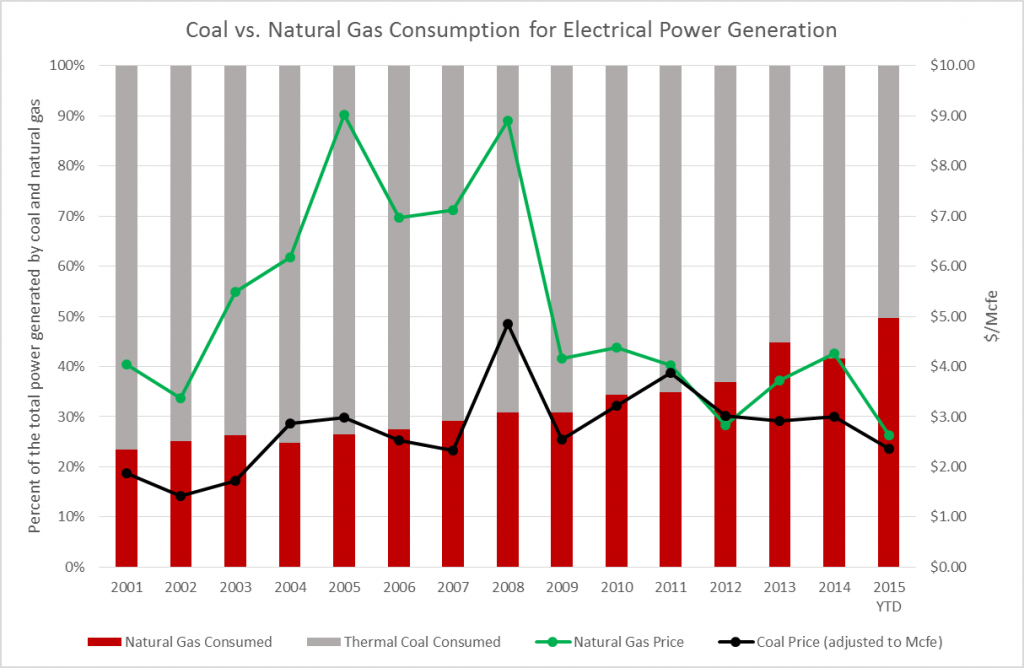Carbon dioxide (CO2) emissions has been a constant topic of discussion for a number of years, and the electric power sector was among the largest producers of CO2 as a byproduct of power generation. Emissions were on a constant move upward from 1990 to 2008 when it began to level off. According to data from the EIA, carbon dioxide emissions from the electric power sector have been on the downswing over the last 8 years. Carbon dioxide emissions from electricity generation totaled 1,925 million metric tons in 2015, the lowest since 1993 and 21% below their 2005 level. A shift on the electricity generation mix, with generation from natural gas and renewables displacing coal-fired power, drove the reductions in emissions.
Fuel sources for electrical power generation have been influenced by two major factors. One is government legislation and the desire to reduce carbon emissions. The Clean Power Plan has called for the decreased use of coal in power generation in favor of cleaner burning natural gas. The second is the pricing differential between coal and natural gas, as the price differential diminishes, the economic incentive to use coal decreases as well. In recent years, the drop in natural gas prices, coupled with increased efficiency from natural gas-fired combined-cycle technology, made natural gas an attractive choice to meet demand previously met by coal.
Recent shifts in the electricity generation mix have implications for both total energy consumption and energy-related CO2 emissions. Coal plants tend to have relatively low thermal efficiency compared to plants using combined-cycle technology fueled by natural gas. Although there is some variation across individual plants, in general a coal plant consumes more energy than a combined-cycle natural gas plant to produce the same amount of electricity. Also, coal’s carbon content per unit of energy is nearly twice that of natural gas. Considering both the higher thermal efficiency of generators and lower carbon content of fuels, electricity generation using natural gas emits roughly 40% of the carbon dioxide that would be emitted from a coal-fired unit producing the same amount of electricity.
In March 2016, NET Power announced the development of a zero-emission natural gas plant that would begin construction for a demonstration phase. The hope is that the development of this technology can help reduce the emissions from natural gas plants even further.
Changes in the electric generating mix outside of natural gas and coal have also worked to reduce CO2 emissions. Renewable energy sources are gaining an increasing share of generation as they proliferate across the country and around the world. The increased capacity is driven primarily by wind and solar generation and the efficiencies created in recent years. Renewable energy has a way to go to catch fossil fuels, but is making strides to garner more of the market. Nuclear generation was relatively flat over the past decade but remains the single largest source of generation without CO2 emissions.
Power Generation by Sector
The reductions in CO2 emissions are spread out among the different end-use sectors in proportion to the share of total electricity sales to each sector. Overall, the fuel-use changes in the power sector have accounted for 68% of the total energy-related CO2 reductions from 2005 to 2015.
The amount of CO2 emissions in the primary (non-electricity) energy mix of end-use sectors has also changed. In the residential and commercial sectors, primary energy such as natural gas is used mainly for space heating, water heating, and cooking. In the industrial sector, many processes rely on the direct consumption of fossil fuels to produce heat. Most of the energy consumed in the transportation sector is primary energy in the form of motor gasoline, diesel fuel, and jet fuel.





